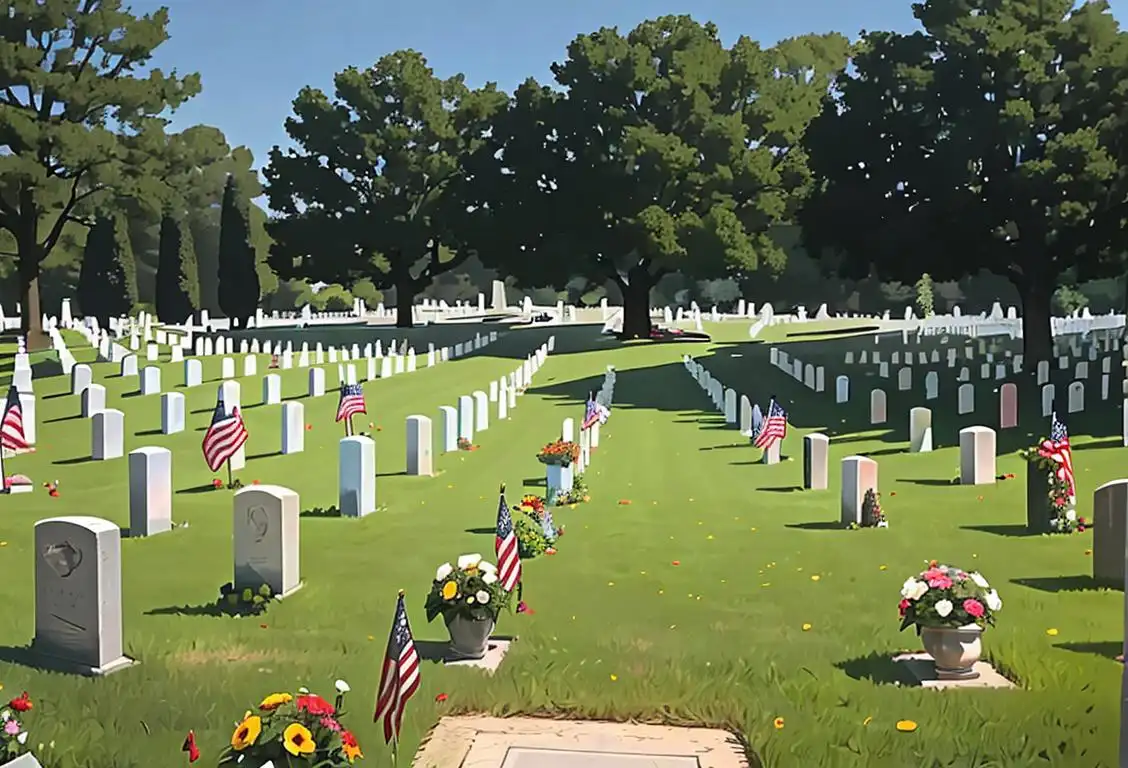National Cemeteries For Memorial Day

Ah, Memorial Day. The time of year when we enjoy the warm weather, fire up the grill, and gather with loved ones to remember and honor those who have made the ultimate sacrifice for our country. But do you ever wonder how this day became a national holiday? Let's dive into the internet history of Memorial Day and explore the significance of national cemeteries.
When is Cemeteries For Memorial Day?
It's national cemeteries for memorial day on the 18th May.
The Origins of Memorial Day
Memorial Day, originally known as Decoration Day, can trace its roots back to the post-Civil War era. It was a time when the country was healing from the wounds of war, and people wanted to find a way to remember and honor the fallen soldiers.
The practice of decorating the graves of fallen soldiers was already a common tradition, particularly in the South. However, it wasn't until May 5, 1868, that General John A. Logan officially proclaimed May 30th as Decoration Day, a time for the nation to decorate the graves of the war dead with flowers and flags.
A National Day of Remembrance
As the years went by, Decoration Day evolved into Memorial Day. It became a day to not only remember those who died in the Civil War but also to honor all American soldiers who have sacrificed their lives in military service.
In 1971, Memorial Day was declared a national holiday by an act of Congress. It was moved to the last Monday in May to create a three-day weekend and give people an opportunity to come together as a community and pay their respects.
National Cemeteries: Sacred Grounds
One of the most important aspects of Memorial Day is the recognition of national cemeteries. These hallowed grounds serve as the final resting place of countless veterans, offering a place of honor, dignity, and remembrance.
The establishment of national cemeteries began during the Civil War, when the sheer number of casualties made it necessary to have dedicated burial sites. Today, national cemeteries are managed by the Department of Veterans Affairs, ensuring that veterans from all branches of the armed forces receive a proper and dignified burial.
These cemeteries, with their rows of pristine white headstones, serve as a poignant reminder of the sacrifices made by our servicemen and women. They provide a place for loved ones to visit and pay their respects, and they allow us to reflect on the cost of freedom.
Did You Know?
Did you know that the first national cemetery was established at Arlington, Virginia? Originally the estate of Robert E. Lee, it was taken over by the Union Army during the Civil War. Today, Arlington National Cemetery is a solemn and awe-inspiring place, with over 400,000 gravesites and the Tomb of the Unknown Soldier.
History behind the term 'Cemeteries For Memorial'
1660
The Rise of Urban Burial Grounds
As cities in Europe began to grow in the 17th century, the need for organized burial grounds arose. Traditional churchyards were becoming overcrowded and unhygienic, prompting the establishment of cemeteries outside the city limits. These new burial grounds were designed to provide a peaceful resting place for the deceased, away from the hustle and bustle of urban life.
1831
Garden Cemetery Movement Begins
The history of cemeteries for memorial dates back to 1831 when the Garden Cemetery movement began in the United States. Mount Auburn Cemetery in Cambridge, Massachusetts, is considered the first 'Garden Cemetery' in the country. These cemeteries were designed to be peaceful, park-like spaces that emphasized natural beauty and served as places for quiet reflection and remembrance.
1661
Early Burial Grounds
The concept of cemeteries for memorial can be traced back to the establishment of early burial grounds. In 1661, the first public burial ground, known as the King's Chapel Burying Ground, was opened in Boston, Massachusetts. This marked a shift from the previous practice of burying the dead in churchyards. The idea of having designated places for burials had a profound impact on the cultural landscape and led to the development of formal cemeteries for memorial.
1847
Creation of the modern cemetery
In 1847, the modern concept of cemeteries as we know them today was born in the United States. Prior to this, burials took place in churchyards or family plots, creating overcrowding and unsanitary conditions in urban areas. The Mount Auburn Cemetery in Cambridge, Massachusetts was the first of its kind, featuring open green spaces, landscaped gardens, and architectural features. This new style of cemetery provided a peaceful and scenic environment for mourning loved ones, and its success led to the establishment of cemeteries across the country.
1804
The Word Cemetery Takes Hold
In 1804, the term 'cemetery' was first used in English, derived from the Greek word 'koimētērion,' meaning 'sleeping place.' This new term reflected the growing emphasis on creating burial spaces that were serene and tranquil, contributing to the concept of cemeteries as places of memorial and remembrance.
1861
The rise of Civil War memorials
During the American Civil War, which began in 1861, the number of casualties was unprecedented. This led to a heightened awareness of the need for commemorating the fallen soldiers. Cemeteries began to serve as memorials, not only for individual graves but also for larger structures and monuments. One example is Arlington National Cemetery in Virginia, which was originally a plantation owned by the family of Robert E. Lee. It was confiscated by the Union Army and transformed into a military cemetery, becoming a symbol of honor and remembrance for the nation's heroes.
1832
Mount Auburn Cemetery Established
In 1832, Mount Auburn Cemetery officially opened its gates. It quickly became a popular destination for visitors seeking solace and tranquil surroundings. The cemetery's design featured winding paths, picturesque landscapes, and carefully curated plantings. Its success inspired the creation of similar garden cemeteries across the United States.
1831
Mount Auburn Cemetery
The year 1831 is a significant milestone in the history of cemeteries for memorial with the establishment of Mount Auburn Cemetery in Cambridge, Massachusetts. Mount Auburn Cemetery was the first large-scale, non-denominational cemetery in the United States. It introduced the concept of landscaped cemeteries, incorporating natural beauty and ornamental plantings. This innovative approach revolutionized the perception of burial grounds, inspiring the creation of similar cemeteries across the nation.
1838
Père Lachaise Cemetery
In 1838, Père Lachaise Cemetery in Paris, France, was established. It is one of the most famous and visited cemeteries in the world. Père Lachaise became a model for future cemetery designs, with its grand monuments, elaborate tombs, and tree-lined avenues. Its popularity further fueled the interest in creating aesthetically pleasing cemeteries focused on memorializing the departed.
1882
The introduction of Memorial Day
In 1882, the United States officially recognized Memorial Day as a national holiday. This day was initially observed on May 30th and later moved to the last Monday in May. Memorial Day provided an opportunity for the nation to collectively remember and honor those who had died in military service. It also became a time for families to visit cemeteries and decorate the graves of their loved ones with flowers and flags. The establishment of Memorial Day further solidified the connection between cemeteries and memorialization.
1831
Père Lachaise Cemetery Captures Public Imagination
Père Lachaise Cemetery in Paris, France, opened its gates in 1804, but it was in the early 19th century that it gained significant popularity. Artists, writers, and other notable individuals were buried there, attracting visitors who admired their work. This phenomenon sparked a fascination with cemeteries as places not only for mourning but also for honoring influential figures, giving rise to the idea of cemeteries as sites of cultural significance.
1852
Père Lachaise Cemetery
In 1852, Père Lachaise Cemetery in Paris, France, brought a new dimension to cemeteries for memorial. This historic cemetery became renowned for its grandeur and became a sought-after burial place for notable individuals. The interment of famous personalities like Oscar Wilde, Frédéric Chopin, and Jim Morrison contributed to the cemetery's increasing fame and attracted visitors from around the world. Père Lachaise Cemetery served as an influential model for future memorial parks.
1863
Gettysburg National Cemetery
The establishment of the Gettysburg National Cemetery in 1863 marked a pivotal moment in the history of cemeteries for memorial in the United States. As the final resting place for soldiers who perished during the Battle of Gettysburg, this cemetery symbolized the nation's commitment to honoring and remembering the fallen. President Abraham Lincoln's famous Gettysburg Address further emphasized the importance of memorializing those who gave their lives in service to their country.
1850
Cultural Shift towards Memorialization
During the mid-19th century, there was a noticeable cultural shift towards the practice of cemetery memorialization. Monuments, statues, and elaborate tombstones started to replace simple markers. Cemeteries became not only places for burial but also important sites of remembrance and historical interest, further solidifying the notion of cemeteries as spaces for memorial.
20th century
Expansion of cemetery services
As the 20th century progressed, cemeteries evolved to provide a wider range of services beyond traditional burials. Cremation gained popularity, leading to the incorporation of crematoria within cemetery grounds. Mausoleums, columbaria, and other structures were built to accommodate different cultural and religious practices. Memorial gardens and scattering areas were also developed as alternative options for those who preferred not to have a physical grave. These innovations broadened the concept of cemeteries and expanded their role in memorializing the departed.
1863
Arlington National Cemetery: A Symbol of Sacrifice
During the American Civil War, Arlington National Cemetery was established in Virginia as a military burial ground. The cemetery's purpose expanded over the years to honor fallen soldiers from other conflicts, including both World Wars. Arlington National Cemetery became a poignant symbol of the sacrifice and valor associated with military service, amplifying the concept of cemeteries as places of national memorial and heroism.
1969
Creation of Memorial Gardens
In the late 20th century, the concept of memorial gardens gained prominence. These gardens were designed to provide a peaceful environment for reflection and remembrance, often incorporating elements of nature and landscaping. Memorial gardens offered an alternative to traditional cemeteries, fostering a deeper connection between the living and the memory of their loved ones, and further promoting the idea of cemeteries as places of solace and commemoration.
Present day
Continuing significance of cemeteries for memorial
In the present day, cemeteries continue to play a vital role in memorializing the deceased and preserving their memory. They provide a peaceful and contemplative space for individuals to reflect on their loved ones and pay their respects. Many cemeteries now offer guided tours, educational programs, and historical exhibits that contribute to the cultural heritage of their communities. Additionally, cemetery architecture and landscaping have become subjects of artistic and architectural appreciation. Cemeteries for memorial have become deeply ingrained in the cultural fabric of societies worldwide.
20th Century
Modern Cemetery Design
Throughout the 20th century, cemetery design continued to evolve. Modern cemetery architecture saw the emergence of mausoleums, cremation gardens, and columbaria as alternative options for memorialization. Cemeteries increasingly incorporated various cultural and religious symbols and motifs to accommodate the diverse heritage and beliefs of the communities they served.
Today
Cemeteries for Memorial
Today, cemeteries continue to serve as important places for memorial. They provide spaces for families and friends to honor and remember their loved ones. The concept of cemeteries as tranquil environments for reflection and commemoration persists, despite the changes in burial practices and design trends. Cemeteries for memorial remain an integral aspect of our cultural heritage.
Did you know?
Did you know that the first national cemetery was established at Arlington, Virginia?Tagged
awareness loved ones rememberanceFirst identified
18th May 2020Most mentioned on
18th May 2020Total mentions
86Other days
Cheese Lovers Day
Teddy Bear Day
Sibs Day
Biscuit Day
Cancer Survivors Day
Agriculture Day
Pumpkin Day
Suicide Prevention Day
Memorial Day
First Responders Day









